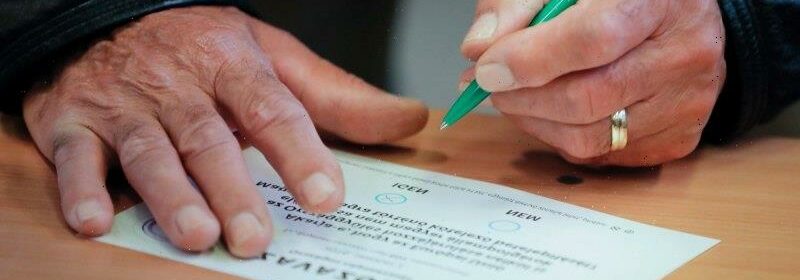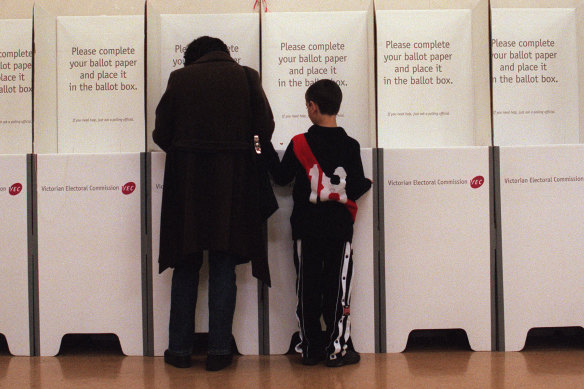Vote below the line – help democracy

Victoria’s voters have two choices on the large ballot paper for the Legislative Council as to how to vote at next week’s state election. They can vote above the line for a party, in which case preferences will be assigned based on group tickets lodged by that party, or below the line by numbering boxes for the candidates.
I recommend all voters vote below the line and help protect democracy from preference ticket deals. If you give preferences between parties above the line as nearly all voters did in the Senate in May, your choices will be ignored and overwritten.
Young voters hold more power in Victoria since the last state election.Credit:James Boddington
In Victoria’s Group Ticket Voting system, micro-parties construct networked “preference harvesting” trades with other micro-parties. When each micro-party is excluded, its above the line preferences are sent to other parties that even its own voters have never heard of. The micro-party with the best deals and the best luck outlasts the others and often a party that polled very few primary votes wins at the expense of more popular parties. Bigger parties often also send their preferences to suspect micro-parties, making it even easier for parties to win that don’t deserve to.
The many “random” MPs who win by this method (in 2018 with as little as 0.62 per cent of the vote) could be good or bad as politicians, but that’s not the point. The point is they are not there on merit and are not all that accountable to voters. Whether they get re-elected has more to do with networked preference deals than whether their tiny shares of the primary vote go up or down.
Dan Andrews celebrates after his re-election in 2018. At the poll, some candidates were elected with only 0.62 per cent of the vote.Credit:Joe Armao
If anything they do offends backroom consultants who construct preference deals, their careers could be over.
If you vote below the line, you control your preferences, and you know who they benefit. It might seem that under the current system voters only need to look up the lodged group tickets to see what a vote cast above the line will do, but several of the tickets are ordered so that they appear to help one party but actually help another.
Also, many micro-parties that receive preferences (even from the most principled party tickets) are deceptively named. Micro-parties with harmless-sounding names are often fronts for right-wing extremism or anti-vaccination campaigns, while parties that sound committed to a cause can be joke parties set up to harvest votes.
The more voters vote below the line, the more the methods that preference-harvesters use to elect candidates with no support can be derailed.
In 2018, 9 per cent of voters voted below the line, but even that stopped three preference spirals in their tracks. The more voters vote below the line, the fewer MPs will be elected who are in thrall to the preference-harvesting system, and the better the chances that the system will be fixed for good.
Voting below the line does take a little more effort, but it’s no harder than voting in the Senate. At minimum, you can just number five candidates (which might be as easy as, say, 1-2-3 from one party and 4-5 from another), but I recommend going a bit further. Number all the candidates from all the parties that you like or think are alright, unless there are specific candidates who you don’t want to support. That will help protect all those parties from losing to anyone else, without sending your vote to any party that doesn’t deserve it.
Don’t feel you need to spend time researching parties you’ve never heard of. It’s the parties’ job to make themselves known to you, so if you don’t know enough about a party you’ve got every reason to omit them or push them well down your order.
If you want to cast the most effective vote possible and have the time and energy, you could even number every box below the line – but that takes work! If doing so, prepare your vote beforehand and take a printout with you to the booth. Online voting websites like Cluey Voter can be very helpful here. There’s a myth that putting numbers next to the boxes of candidates you disapprove of can help them beat the candidates you like. In fact, so long as you put the candidates in order of your preference, your vote can never reach any candidate until all the candidates you put above them have won or lost. It’s the top few boxes you number that are most likely to have an impact, but voting all the way through could in theory help parties you mildly dislike beat parties you are strongly opposed to.
Dr Kevin Bonham is an independent psephologist and political commentator.
The Morning Edition newsletter is our guide to the day’s most important and interesting stories, analysis and insights. Sign up here.
Most Viewed in National
From our partners
Source: Read Full Article

